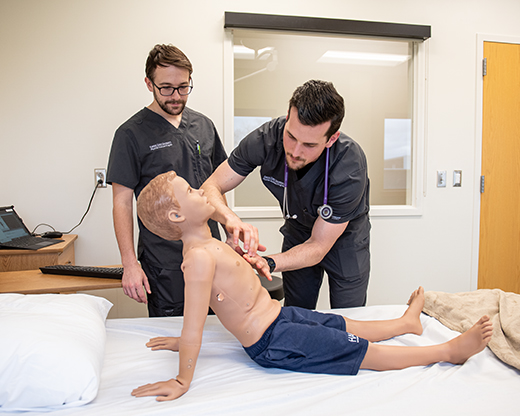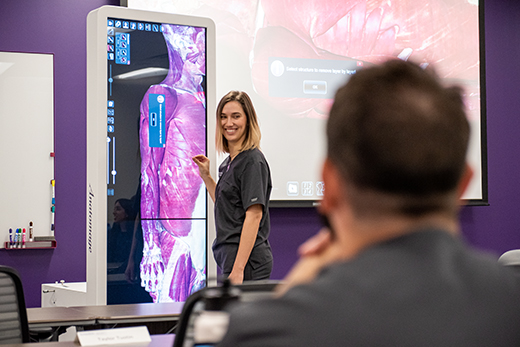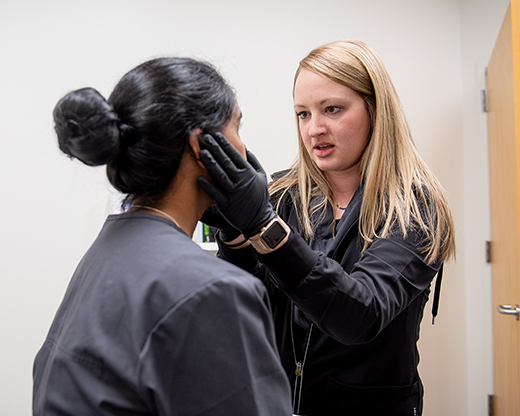Rural Kansas needs health care providers. K-State's first physician assistant cohort is stepping up.
Thursday, May 16, 2024

Michael Loree, left, and Grayson Bingham practice their examination skills on "Hal Jr.," an advanced patient simulator. The K-State physician assistant program also has adult and infant-sized patient simulators that allow students to practice various medical skills, including airway management, IV placement and trauma treatment, among others. | Download this photo.
MANHATTAN — They all came for different reasons and from different sources of inspiration, but the end goal was the same — to help people with broken noses, bacterial infections and any other number of medical maladies.
As the inaugural cohort of Kansas State University's physician assistant studies program finishes 27 months of intensive classroom and clinical training, its students are excited to make a difference in treating acute and chronic illnesses and injuries, especially in areas that face health care shortages.
"Our first cohort set the standard for the program," said Gwen Ferdinand-Jacob, director of the program and a physician assistant herself. "They helped us learn how to best teach students and prepare them for jobs as physician assistants."
K-State's physician assistant graduates are trained to meet common medical needs
K-State's physician assistant program began as a concept several years ago when the university saw a statewide need for more health care providers.
Out of Kansas' 105 counties, more than 60 are medically underserved under the state's standard for primary medical care, according to the Kansas Department of Health and Environment's latest .
A physician assistant studies program was identified as a way to develop medical providers who may not have the advanced knowledge of physicians but would still undergo intense medical training to complete most tasks while still being under the supervision of a fully credentialed physician.
Think someone who could help "relieve, but not replace, the doctor role, especially as there's always been physician shortages," said Amy Fitzgerald, academic director for the program and a physician assistant.
"We're trained in the common," Fitzgerald said. "That's not to say we're not trained in the uncommon, but our goal — and that of most other PA programs — is to train broadly and teach responses to those common injuries and illnesses you'll run into."

Alexa Tkachuck, a member of the inaugural cohort of Kansas State University's physician assistant studies program, reviews anatomy using the vertical Anatomage table. The interactive anatomical dissection table allows students to simulate and examine various types of health issues on virtual bodies. | Download this photo.
K-State's physician assistant studies program started in January 2022 as a 27-month graduate-level program in the College of Health and Human Sciences, split between 12 months of deep classroom education — 8 a.m. to 5 p.m. every single weekday — and 15 months of clinical experience at various sites around the region.
Even in the classroom learning portion of their training, the students had the chance to receive hands-on experience with trauma patient simulators in mock exam rooms and virtual 3D anatomical dissection tables.
Many physician assistants work in family practice environments, but some may further specialize by pursuing careers in fields such as interventional radiology, cardiothoracic surgery and neurosurgery, among others.
Besides the medical training, then, the K-State physician assistant program's instructors focused on teaching students to approach their jobs with professionalism and empathy for their patients, said Ferdinand-Jacob.
"It's easy to teach the science, because that is often either right or wrong," Ferdinand-Jacob said. "It can be difficult to teach the compassion and care needed to excel as a PA, but this cohort has really developed and grown in those skills these past 27 months."
Tavi Garcia, a physician assistant student from a small farm town in Jalisco, Mexico, said he appreciated the smaller class sizes and one-on-one opportunities he had with professors.
It's learning he'll take with him as he prepares to work at a health center in rural Idaho after passing his national boards.
"Through the program, I learned how to really work well with patients and recognize what I could do to help them medically," Garcia said. "I also really loved the focus we had on working with underserved populations, especially here in Kansas."
More health care provider relief is in the K-State pipeline
Now that the initial cohort of physician assistant students has graduated, a second cohort of 40 students is completing clinicals, while the third cohort of 44 students — the program's target size going forward — started classroom instruction in January.
While the first cohort has completed their education, the 35 students are preparing to take their national certification exams in the coming weeks. That certification will allow them to obtain their medical licenses in whichever state or jurisdiction they hope to practice in.
At any rate, many of the graduates already have jobs lined up contingent on their certification, Fitzgerald said. The initial goal in recruiting students to the program was to get at least 20% from Kansas, since they would be more likely to remain in the state.
The program is up to about 50% now, though, and even out-of-state students are seeing opportunities in the Sunflower State.

Taylor Niemeier, a member of the inaugural cohort of Kansas State University's physician assistant studies program, practices examination skills on Swathi Punreddy, another member of the cohort. Students learn about and practice hands-on examination skills during the first 12 months of the 27-month program. | Download this photo.
"Our approach, initially, was thinking that most students would have to be from Kansas to want to stay in Kansas," Fitzgerald said. "But that hasn't necessarily turned out to be true, and many of our students are thinking that maybe they too could stay and work in communities around the state."
Taylor Niermeier, a physician assistant student from Gove who graduated this spring, plans to return to northwest Kansas, where she has a tentative job with a local health care provider.
Niermeier said she is proud to have helped set a standard for the physician assistant program as a member of its inaugural cohort.
"As a class, we were able to help change and mold the program to fit the needs of students," she said. "We worked with faculty to make this program successful, and we were able to make an impact by bettering the profession and helping it grow."
